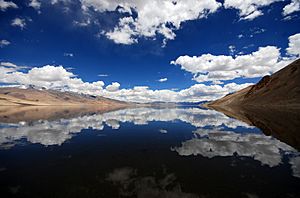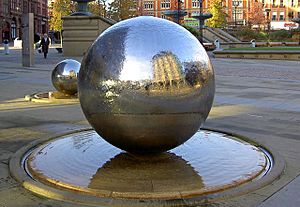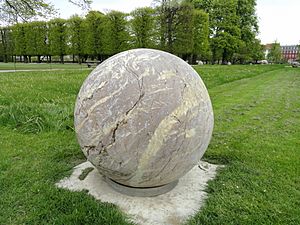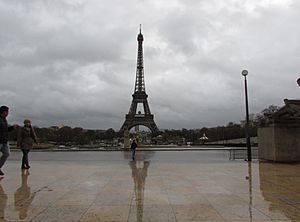Specular reflection facts for kids
Specular reflection is when light or other waves bounce off a surface in a very neat, mirror-like way. Think about looking at your reflection in a shiny mirror or a calm lake. That's specular reflection!
This type of reflection follows a special rule called the law of reflection. This law says that a ray of light bounces off a surface at the same angle it hit it. Imagine a line standing straight up from the surface (this is called the surface normal). The light ray comes in at a certain angle to this line, and it bounces off at the exact same angle, but on the other side of the line. This rule was first explained by an ancient Greek scientist named Hero of Alexandria a long, long time ago.
Specular reflection is different from diffuse reflection. With diffuse reflection, light scatters in many different directions, like when light hits a rough wall.
How Light Bounces Off Surfaces
When light hits the edge of a material, like air meeting glass, it can do a few things. It can bounce off (reflect) or go through (refract). How much light reflects depends on things like the type of material, the color of the light, and the angle at which the light hits the surface. Generally, more light reflects when it hits the surface at a very flat angle.
There are two main ways light reflects:
- Specular reflection: This is like a mirror. All the light coming from one direction bounces off at the same angle.
- Diffuse reflection: Here, the light scatters in many different directions.
Think about paint:
- Shiny, glossy paint shows a lot of specular reflection. You can often see reflections in it.
- Matte paint, which isn't shiny, shows mostly diffuse reflection. It scatters light, so you don't see clear reflections.
Materials like polished metal or the silver coating on a mirror are very good at specular reflection. Surfaces made of rough powders, like plaster, are good at diffuse reflection.
Understanding the Law of Reflection
Light travels as waves. We can imagine a "ray" of light as a straight line showing the direction the wave is moving. When a light ray hits a surface, the angle it makes with the straight-up line (the surface normal) is called the angle of incidence. The area where the light ray, the surface normal, and the reflected ray all exist is called the plane of incidence.
The law of reflection has two main parts:
- The angle at which the light bounces off (the angle of reflection) is exactly the same as the angle at which it hit (the angle of incidence).
- The incoming light ray, the surface normal, and the outgoing reflected ray all lie on the same flat surface (they are coplanar).
If light hits a surface straight on (at a 90-degree angle), it bounces straight back in the direction it came from.
Where Can We See Specular Reflection?
The most common example of specular reflection is a mirror. Mirrors are specially made to reflect light perfectly.
But specular reflection isn't just for visible light! We can see it with other types of waves too:
- Radio waves: Radio signals can bounce off the ionosphere (a layer in Earth's atmosphere) in a specular way.
- Radar signals: Radar uses radio or microwaves to detect objects like airplanes. These signals reflect off the objects specularly.
- X-rays: Scientists use x-ray reflectivity to study very thin layers of materials and surfaces with amazing detail.
Even non-light waves can show specular reflection:
- Sound: Acoustic mirrors are designed to reflect sound waves.
- Atoms: Believe it or not, even tiny atoms can be reflected by special "atomic mirrors."
- Neutrons: Neutron reflectometry uses specular reflection of neutrons to study surfaces, similar to how x-rays are used.





